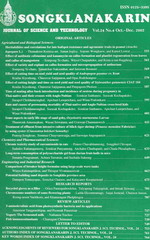ThaiScience
ThaiScience
SONGKLANAKARIN JOURNAL OF SCIENCE & TECHNOLOGY
Volume 41, No. 05, Month SEPTEMBER, Year 2019, Pages 1154 - 1161
Performance comparison between the iter- and demo-like plasmas using cronos simulations
Boonyarit Chatthong, Jiraporn Promping
Abstract Download PDF
This work investigates plasma performance and fusion power production of the ITER- and DEMO-like plasmas using the integrated predictive modelling code CRONOS. These plasmas are simulated in the presence of an edge transport barrier (ETB). The transport effect includes both neoclassical and anomalous contributions. The neoclassical transport is described using the NCLASS module, while the anomalous transport is calculated using a semi-empirical Mixed Bohm/gyro-Bohm model. The boundary conditions for the transport equations are set at the top of the pedestal where the ETB forms. The pedestal height is calculated based on the scaling law. The time evolution of plasma current, temperatures, and density profiles of the ITER and DEMOs that include the Chinese, Japanese, Korean, Indian, and European designs, are simulated based on their engineering designs and conceptual plans. It was found that the European Model B yielded the highest temperatures and total fusion power. The ITER design generated high fusion Q, while both the ITER and Japanese DEMO yielded the longest energy confinement time. The highest bootstrap fraction was found in the Korean DEMO.
Keywords
plasma, tokamak, fusion, ITER, DEMOSONGKLANAKARIN JOURNAL OF SCIENCE & TECHNOLOGY
Published by : Prince of Songkla University
Contributions welcome at : http://rdo.psu.ac.th
